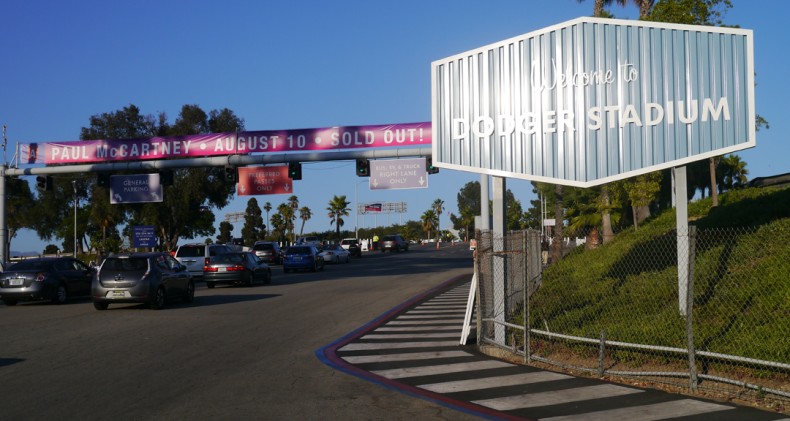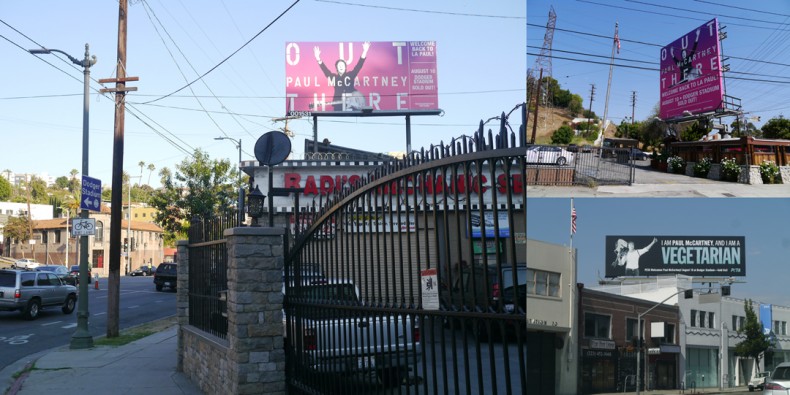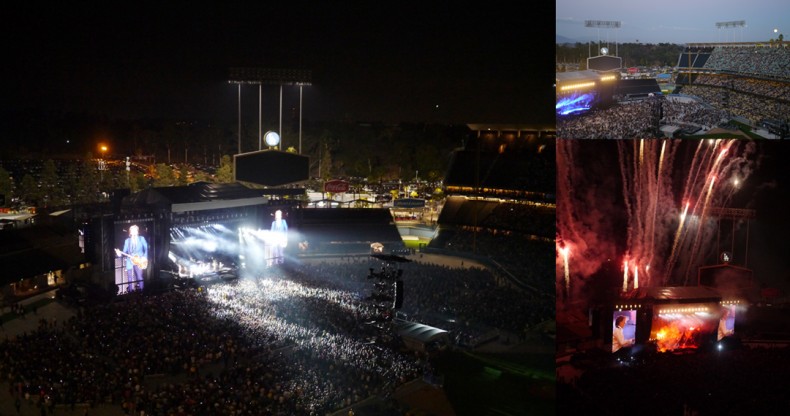Aug 12, 2014 Paul McCartney at Dodger Stadium

When I was a junior high student who was just starting to buy records, I wasn’t a fan of The Beatles. I thought it was weird for classmates to wear T-shirts with John, Paul, George, and Ringo. Why didn’t they support more current, more local music, more underground music? No Elvis, Beatles, or the Rolling Stones, right? And what’s up with wearing band gear that was bought at the mall instead of a merch table at a show? Not acceptable, and McCartney’s solo songs and duets with Michael Jackson at the time were pretty corny.
But the Beatles’ musical genius and legacy are impossible to resist or deny–with covers by The Damned, Siouxsie and The Banshees, and Shonen Knife providing a gateway–and I was stoked to get to see Paul McCartney at Dodger Stadium on Sunday night.
The billboards around Chavez Ravine should have been enough to get us ready for Sir Paul’s much-publicized return to the legendary venue, 48 years after his old band famously played its second-to-last show there to nonstop screaming fans. (I particularly liked the sign above the PETA headquarters in Echo Park.) But leading up to the show was a stream of vintage photos and videos reminding us of his role in the evolution of popular music while a DJ played mash-ups and covers to reinforce his diverse and lasting influence.
As anticipated, McCartney’s set was nearly three hours instead of 30 minutes like his last appearance in Blue Heaven. And you could actually hear the songs. When he asked if anyone in the audience was there the last time he played after “We Can Work It Out,” the screams weren’t quite as loud as before.
What surprised and impressed me was that the economy his band didn’t seem so different now than how it must have been when he and his fab bandmates from Liverpool were barroom rockers honing their chops and instincts by covering R&B hits back in the day. They were a relatively stripped down (yet fierce) five-piece–compared to sizable musical and vocal reinforcements that the Stones took with them on their recent 50th anniversary tour or the double-digit E Street Band that accompanies The Boss. No songs were more than four or five minutes long. All killer, no filler. After four numbers, he removed his jacket and deemed it “the only wardrobe change in the whole evening.”
And there was a lot of great chitchat between songs, too, making the stadium feel more intimate. After appending a “Foxy Lady” jam onto Wings’ stoner anthem, “Let Me Roll It,” the lefty bassist talked about meeting the lefty guitarist and what a great guy he was. Two days after Sgt. Pepper’s was released, Jimi learned it and opened a show with it–the ultimate compliment to McCartney. He described “Blackbird” as a song that was originally written about civil rights and has been covered incorrectly ever since, and dedicated “Something” to Harrison and “Here Today” to Lennon. What, no mention (or appearance) of Ringo?
Many old songs had new meanings or nuances. “Back in the U.S.S.R.” was extra interesting because the Cold War is over, the Soviet Union is gone, and we were right up the hill from Studio One, where Shepard Fairey specializes in the Eastern Bloc-inspired graphics that accompanied the song. (And is the Cold War really over?)”Lady Madonna” was illustrated by a montage of strong women including Tina Turner, Diana Ross, Lady Diana, Josephine Baker, Elizabeth Taylor, Wilma Rudolph, Mother Teresa, and… Linda McCartney. He played some new songs, too. I thought they were catchy and great and they provided opportunities for more discriminating listeners to visit the bathroom or get some nachos, as well.
There was a funny moment after playing “I’ve Just Seen a Face” when the godlike Macca admitted that he sometimes gets distracted by the signs that fans bring to shows. One was held by a young lady asking the ex-Beatle to sign her mom’s arm for her first and only tattoo. In the first encore, he honored their wish onstage. Will they go through with it? Should they?
It was the second encore that really encapsulated the night, from the deceptive simplicity of “Yesterday” to the pre-punk shredding of “Helter Skelter” to the epic closure of “Golden Slumbers/Carry That Weight/The End.” McCartney seemed to make fun of the fireworks that were set off during “Live or Let Die” but those last three selections out of 39 were as impeachable as they were different as they were groundbreaking. And it’s sick that he could have picked a few dozen other cuts that would have been just as heavy. Many of the best Beatles songs were never even played live by the band that recorded them.
No, paying 50 bucks (plus surcharges) to see a big show at Dodger Stadium is not punk. But Paul McCartney is bigger, badder, and cooler than any genre, style, or label and Sunday night confirmed that gloriously.
Please follow Imprint Culture Lab on Twitter, Instagram, and Facebook for the latest articles, events, and announcements from the team.




